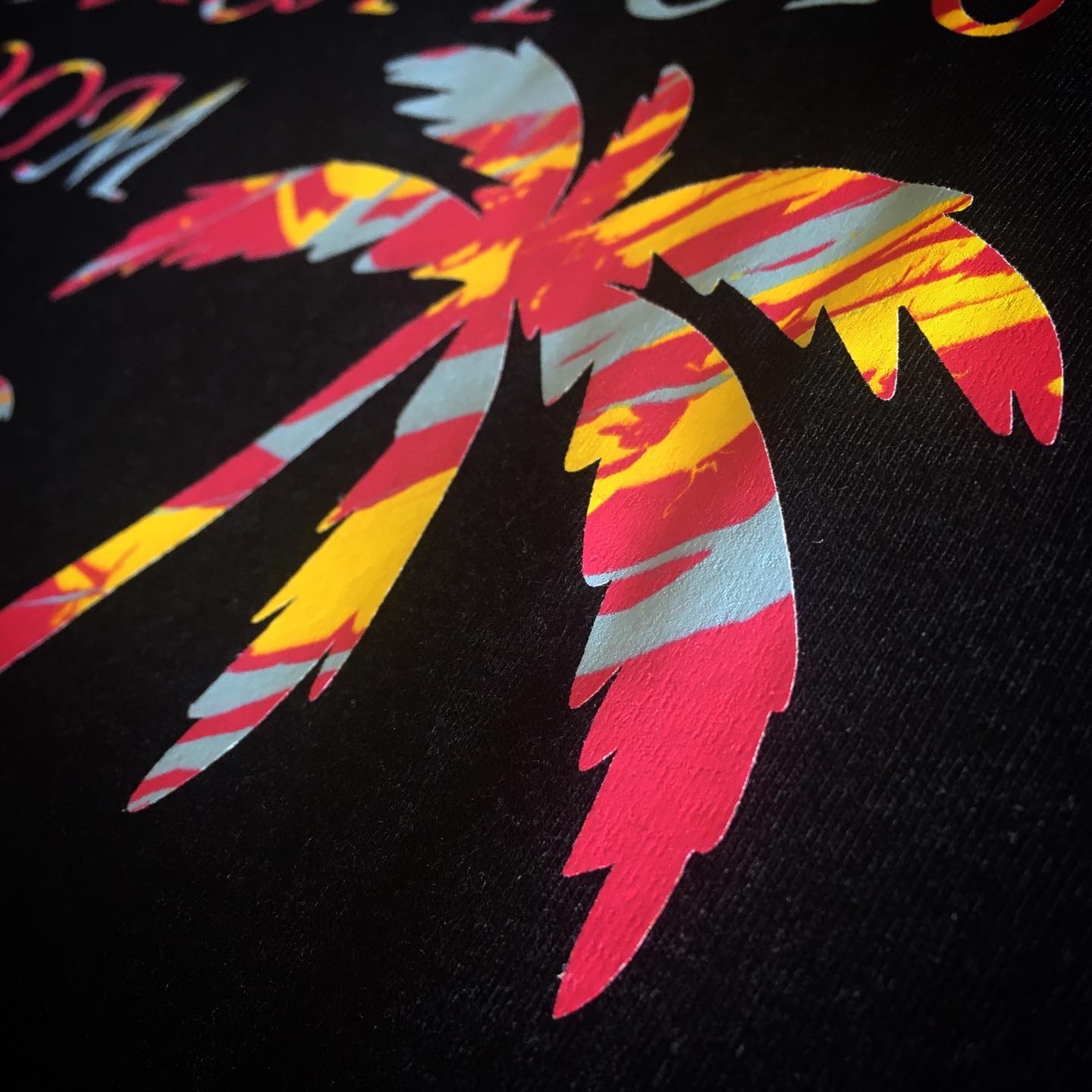Creative T-Shirt Printing Ideas for Small Brands
Creative T-Shirt Printing Ideas for Small Brands
Blog Article
Screen Printing Uncovered: Every Little Thing You Required to Understand About T-Shirt and Garment Printing Strategies
Screen printing is a fascinating technique that integrates art with method, providing unlimited possibilities for creativity. Ready to discover the essential elements that make screen publishing an art type?
The Fundamentals of Display Printing: Just How It Functions
When you dive into display printing, you'll find it's both an art and a science. At its core, screen printing involves producing a stencil, or screen, that enables ink to pass through just in particular locations.
Next, you'll blend your inks and prepare your printing surface. Setting the screen over the fabric, after that use a squeegee to press ink via the display onto the garment. This process calls for precision, as you want clear, vibrant prints. After printing, you'll treat the ink with heat, ensuring it complies with the material and lasts via washes. Each action is vital, and mastering them will certainly raise your screen printing abilities, changing basic garments into one-of-a-kind, expressive items.
Kinds of Screen Printing Methods
Once you comprehend the fundamentals of screen printing, it's time to explore the various strategies that can boost your layouts. One popular method is traditional display printing, where ink is pressed via a stenciled screen.
If you're going for great information, consider discharge printing. This technique eliminates color from the material, leaving a soft, vintage appearance. An additional option is plastisol printing, understood for its toughness and dazzling colors, making it a preferred for several brand names. Lastly, trying out halftone printing to develop gradient impacts and detailed styles. Each strategy has its one-of-a-kind appeal, so don't be reluctant to attempt them out to find what fits your design best!
Crucial Devices for Display Printing
To attain stunning results in screen printing, having the appropriate equipment is fundamental. You'll need a strong screen printing structure, which holds the mesh that transfers your style onto the garment. Next off, invest in high-grade squeegees; these are vital for applying ink uniformly across the screen.
Picking the Right Inks and Materials
When choosing inks and materials for screen printing, you require to consider the kind of ink that functions ideal for your project. Think of material compatibility to ensure your styles look last and fantastic long. Discover green ink alternatives to make your printing process more lasting.
Types of Display Inks
Selecting the best screen ink is essential for attaining vivid, long lasting prints that fulfill your job's demands. There are numerous kinds of screen inks to take a look at. Specialty inks, such as glow-in-the-dark or metallic, can add special results to your styles.

Material Compatibility Factors To Consider
Understanding textile compatibility is essential for accomplishing high-quality display prints, particularly because different materials react distinctly to various inks. Always examine your inks on sample material to guarantee they adhere effectively and maintain shade integrity. In addition, keep in mind that fabric weight and appearance can affect the final end result, so picking the ideal ink and material combination is vital for your project's success.
Eco-Friendly Ink Options
Eco-friendly inks are ending up being a prominent choice for screen printers that want to minimize their environmental effect while preserving top quality. When selecting inks, take into consideration water-based inks, which are much less harmful and simpler to clean up contrasted to standard solvents.
In addition, try to find inks made from renewable energies, such as soy or vegetable-based options. By choosing the best inks and materials, you'll not just develop stunning designs yet additionally contribute to a more sustainable printing process. Make the switch, and your prints will mirror your dedication to the atmosphere!
Preparing Your Style for Display Printing

Submit Format Demands
To guarantee your style looks dynamic and sharp on textile, you'll need to pay attention to submit format requirements for screen printing. Beginning with vector data like AI or EPS, as they can be scaled without losing quality. If you use raster images, decide for high-resolution documents, such as TIFF or PNG, ideally at 300 DPI. Stay clear of using JPEGs, as they can lose clearness when resized. Make certain your design has a clear history to stop undesirable white edges on your prints. Maintain shade settings in mind; CMYK is basic for display printing, so convert your RGB develops appropriately - screen printing kit. By complying with these standards, you'll establish your artwork up for a successful print.
Color Splitting Up Strategies
Color splitting up is an important step in preparing your design for display printing, and understanding it can greatly enhance your print top quality. You'll need to damage your layout right into private colors, as each color needs a different screen during printing. Beginning by recognizing all the colors in your design and develop layers each. You can utilize software application like Adobe Photoshop or Illustrator to isolate and separate shades effectively. Be particular to save each layer as a different data, generally in a style like TIFF or PSD. This precision not just assures exact color depiction yet additionally enhances the printing procedure. By focusing on color separation, you'll accomplish expert and vibrant cause your screen-printed garments.
Resolution and Dimension
Attaining the most effective outcomes in display printing starts with guaranteeing your design has the ideal resolution and size. Preferably, your art work ought to be at the very least 300 DPI (dots per inch) for sharp, clear prints. If you utilize reduced resolution, your final product might look pixelated and unprofessional.
When it involves size, think about the measurements of your print area. Style your artwork to match the final print dimension, preferably producing it in the real measurements you'll be printing. This method, you'll stay clear of any unforeseen scaling issues.
Constantly check your design in both vector and raster styles. Vector graphics can be scaled without shedding quality, making them ideal for display printing. Preparing appropriately will assure your design looks important source impressive on every garment!
Step-by-Step Screen Printing Refine
Display printing is a dynamic procedure that permits you to develop vivid layouts on different surfaces. To get started, you'll require a display, emulsion, and your chosen ink.
After washing out the unexposed solution, your display is all set. Set it up on your printing surface and align your garment beneath it. Put ink onto the display and make use of a squeegee to push the ink via the pattern onto the material. Lift the screen carefully and allow the print completely dry. Lastly, treat the ink utilizing warm to assure sturdiness. That's it! You've effectively screen printed your style.
Tips for Successful Display Printing Projects
While you're diving into your display printing projects, keep in mind that important link prep work is crucial to success. Start by collecting all your products-- inks, garments, mops, and displays. A tidy office assists prevent unwanted mistakes, so clean up before you start.
Next, validate your artwork is high-resolution and effectively sized for your garment. Examine your screen for appropriate direct exposure and clean it completely to prevent spots. When mixing your inks, comply with the manufacturer's guidelines to achieve the ideal uniformity.
During printing, apply also stress with your squeegee for constant outcomes. Don't rush; take your time to validate each print fulfills your requirements. After printing, allow your garments dry completely prior to handling or packaging them.
Last but not least, always keep an example of your help future reference. By doing this, you can evaluate your development and boost your techniques gradually. Pleased printing!

Often Asked Concerns
For how long Does It Take to Establish a Display Printing Job?
Setting up a display printing work generally takes about thirty minutes to an hour. You'll prepare the displays, mix inks, and readjust the press. The time varies based on complexity and experience, so stay organized!
Can I Publish on Various Material Enters Utilizing the Very Same Method?
Yes, you can print on different material types using the very same method, but you'll require to change your inks and settings. Some textiles take in ink in different ways, so experimenting guarantees the most effective results for each product.
What Prevail Blunders to Prevent in Screen Printing?
When display printing, prevent common mistakes like using the wrong ink, neglecting correct exposure times, or skipping pre-press checks. Constantly check your configuration and keep tidy displays to ensure quality outcomes each time.
How Can I Effectively Clean and Maintain My Display Printing Devices?
To properly clean and keep your display printing devices, you should consistently clean displays with suitable solvents, examine squeegees for wear, and assure all devices are saved dust-free and completely dry. Consistency prevents pricey fixings and enhances efficiency.
Is Screen Printing Eco-friendly Compared to Other Techniques?
Screen printing can be much more eco friendly than other techniques, specifically if you utilize eco-conscious materials and water-based inks. By choosing sustainable materials and methods, you reduce waste and lessen your effect on the world.
Display Printing Uncovered: Everything You Need to Know Regarding Tee and Garment Printing Strategies
At its core, screen printing involves producing a pattern, or display, that permits ink to pass with just in details areas. Position the screen over the material, then utilize a squeegee to push ink with the display why not find out more onto the garment. One prominent technique is traditional screen printing, where ink is pushed through a stenciled screen.When choosing inks and products for screen printing, you require to take right into account the kind of ink that functions ideal for your job.
Report this page